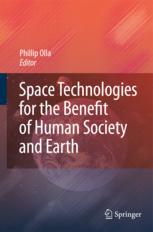Space Technologies for the Benefit of Human Society and Earth edited by Phillip Olla - ISBN 1402095724 - Springer 2009
Motivation
Finding more and state of the art technologies designed for space exploration and discovering that books on the topic, in addition to project pages from NASA and ESA, were available.
Pre-reading model
Draw a schema (using PmGraphViz or another solution) of the situation of the area in the studied domain before having read the book.
Reading
- Preface: The Role of Space Technology in Society
- "the foremost goal of the human race should be to sustain a livable biosphere" (p.v)
- "Integrating space technology with existing ICT infrastructure has the potential to provide further benefits to society, this book presents a collection of chapters from around the globe that highlight the importance and benefits of space applications to society. " (p.vi)
- "Synopsis of Book Chapter Sections" (from p.vii to p.x)
Part I Improving Global Resource Management and Protection of Terrestrial, Coastal and Marine Resources
- Consider using those on the risks of each location in the House page
- 1 SMOS - Earth's Water Monitoring Mission ?! strange paging 30|3 but 40|13
- "The purpose of the SMOS [Soil Moisture and Ocean Salinity] mission is to provide soil moisture and ocean salinity maps from space. " (p3)
- "both variables [water in the soil and salt in the oceans] are intrinsically linked to the Earth's water cycle and climat" (p4)
- "Variability in soil moisture and ocean salinity is due to the continuous exchange of water between the oceans, the atmosphere and the land - the Earth's water cycle. " (p5)
- "In summary, the SMOS objectives are to demonstrate the use of L-Band 2-D interferometric radiometry from space
- To monitor on a global scale soil moisture over land surfaces,
- To monitor on a global scale salinity over oceans, and
- To improve the characterisation of ice and snow covered surfaces
- for
- Advancing climatological, oceanographic, meteorological, hydrological, agronomical and glaciological science,
- Assessing the potential of such measurements to contribute to improve the management of water resources. " (p8)
- "Because of phase fidelity offered by microwave components, antenna complexity can be replaced by signal processing complexity to obtain resolutions which could otherwise not be achieved. " (p8)
- SMOS architecture presented as a system block biagram (p13)
- data submitted to ESA EO Principal Investigator Portal Category-1 (Scientific) (p29)
- "The need for a timely start-up of technology development activities and the maintenance of industrial expertise within Europe has been recognized to ensure a smooth transition from the current SMOS mission to an operational scenario if the opportunity arises. " (p31)
- 2 Indias EO Pyramid for Holistic Development
- "The present in-orbit Indian EO [Earth Observation] constellation of operational satellites and the planned missions have been a part of India�s EO strategy to have specific thematic missions to
- meet the land & water resources management,
- cartography applications, and
- oceanography &
- atmospheric science and
- management requirements besides meeting the needs of the disaster management support programme. " (p37)
- 3 Shifting Paradigms in Water Management
- "This chapter analyses the application of space technology in informing water management and explores the use of technology with respect to meeting agriculture and domestic water demands. " (p57)
- "In the era of a liberalised economy and the implied flow of information and transfer of technology, water management is expected to be more proactive and responsive to user demands and more readily informed by the experts. " (p57)
- "Falkenmark defined water scarcity as <<occurring when the annual per capita water supply of a country is less than 1700m.3 Below 1000m3 per capita a country would be facing water scarcity where water shortages threaten economic development and human health and well-being>>" (p61)
- "[Khroda] goes on to note that water as a resource must be culturally defined because water by itself is not productive: its use requires some minimum level of social infrastructure for it to be productive. " (p61)
- "A proposed solution to addressing second order scarcity is the Integrated Water Resources Management (IWRM), which is a participatory planning and implementation process that brings actors together. " (p63)
- "the selection of technology supports a structure of domination that empowers the urban water supplier with local actors depending on them, effectively making the local actors more vulnerable to decisions made by the water supplier in the operation of the water scheme. The technology installed in water supply includes individual taps, communal taps, boreholes and protected wells. " (p70)
- "The increased availability of the technology, in locations such as Africa where climate change mitigation and adaptation measures are essential and have a huge potential to positively impact and sustain development efforts, determines its potential contribution. " (p72)
- "The interaction of the scientific tools and social decision making processes illustrate the multi disciplinarily approach that is essential in water resources management. " (p73)
- 4 Operational Oceanography and the Sentinel-3 System
- 5 Advanced Space Technology for Oil Spill Detection
Part II Innovative Tele-Heath Applications and Communication Systems
Part III Disaster Monitoring, Mitigation and Damage Assessment
Part IV Space Technologies for the Benefit of Society
See also
Overall remarks and questions
Synthesis
So in the end, it was about X and was based on Y.
Critics
Point A, B and C are debatable because of e, f and j.
Vocabulary
(:new_vocabulary_start:)
quandary
(:new_vocabulary_end:)
Post-reading model
Draw a schema (using PmGraphViz or another solution) of the situation of the area in the studied domain after having read the book. Link it to the pre-reading model and align the two to help easy comparison.
Categories
Back to the Menu
 Fabien Benetou's PIM
Fabien Benetou's PIM






